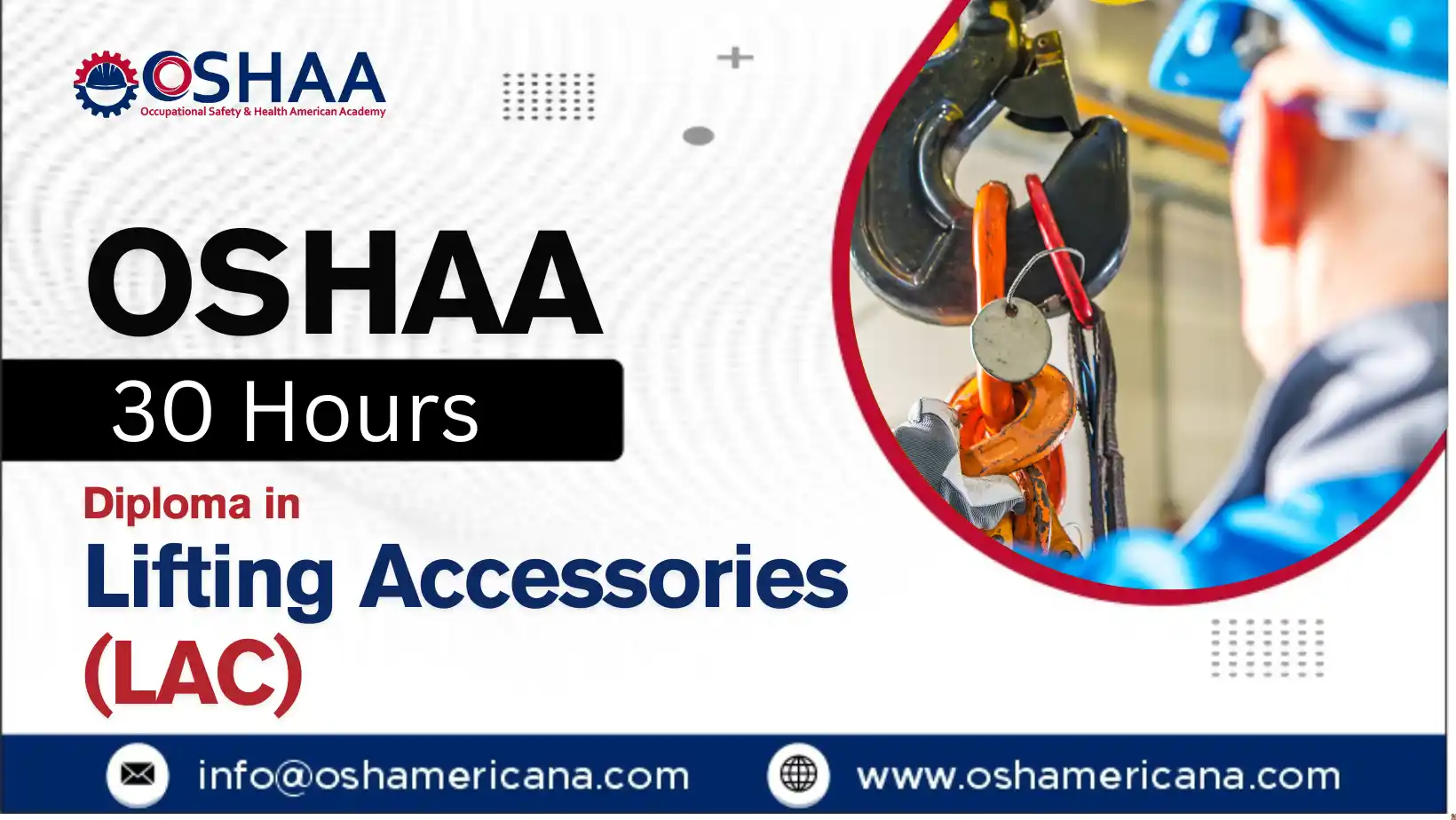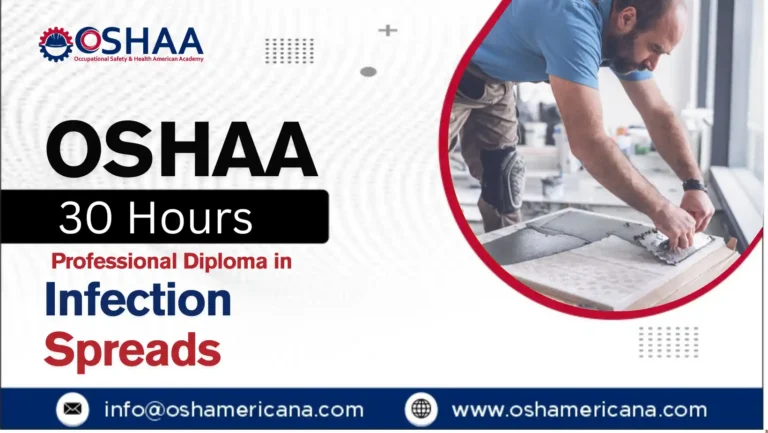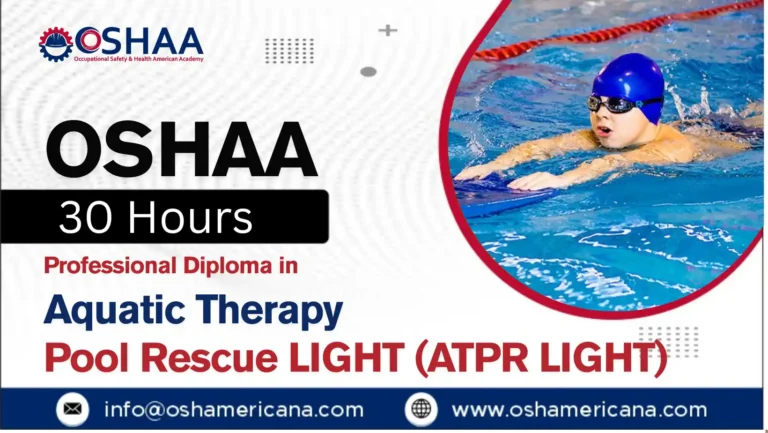The OSHAA 30-Hours Diploma in Lifting Accessories (LAC) is a highly valuable safety training program designed for individuals working in industries that involve material handling, lifting operations, and the use of heavy equipment. This diploma course aims to equip workers, riggers, crane operators, safety supervisors, and engineers with the knowledge and skills necessary to safely use and inspect lifting accessories such as chains, slings, hooks, shackles, spreader beams, and more. By completing this course, professionals demonstrate their commitment to workplace safety and gain a globally recognized qualification that is often a requirement for jobs in oil and gas, construction, marine, shipping, logistics, and other industrial sectors.
The LAC diploma is based on standards issued by OSHAA , ensuring that all participants are trained according to international safety regulations. The 30-hour training covers a wide range of essential topics, including the classification and safe usage of lifting accessories, risk assessments, inspection techniques, load weight estimation, slinging methods, and failure prevention. Learners are also trained to identify hazards, evaluate lifting angles, use lifting charts, and perform proper rigging and signaling during lifting operations. In addition to theoretical training, many institutes offer practical sessions to help participants gain hands-on experience with various lifting tools and equipment.
One of the major advantages of this diploma is its global recognition. Many employers in the Middle East (especially the UAE, Saudi Arabia, and Qatar), as well as in Asia, Europe, and Africa, seek candidates who hold OSHAA or equivalent certifications. The 30-hour duration allows participants to complete the course within a week, making it a quick yet powerful way to advance one’s professional qualifications.
This course is ideal for lifting supervisors, riggers, foremen, site safety officers, HSE engineers, and anyone involved in crane operations or load lifting. There are generally no strict prerequisites; however, having basic English reading skills and some industry knowledge is helpful. Most training providers conduct the course in both online and classroom formats, offering flexibility for working professionals. Some institutions also provide lifetime access to training materials and post-training support to help participants apply their knowledge effectively at their job sites.
Earning this diploma not only enhances safety awareness but also opens doors to better job opportunities, higher salaries, and promotions. Many companies prefer or require workers to complete LAC training as part of their Health and Safety Management System. This certification can also serve as a stepping stone to more advanced HSE diplomas or specialized rigging and lifting supervisor courses.
OSHAA 30-Hours Diploma in Lifting Accessories (LAC)
Study Units
Learning Outcomes
1. Introduction to OSHAA & International Safety Standards (2 Hours)
After completing this unit, learners will be able to:
- Understand the purpose and role of OSHAA in industrial safety
- Identify international safety standards applicable to lifting operations
- Recognize employer and employee responsibilities under safety regulations
2. Types of Lifting Accessories and Equipment (3 Hours)
After completing this unit, learners will be able to:
- Identify various types of lifting accessories such as slings, shackles, hooks, and eyebolts
- Understand the functions, limitations, and applications of different lifting tools
- Classify lifting accessories based on material, configuration, and operational use
3. Load Estimation and Sling Angle Calculations (3 Hours)
After completing this unit, learners will be able to:
- Estimate load weight and determine the center of gravity
- Calculate sling angles and analyze their impact on lifting capacity
- Apply formulas and load charts to ensure safe lifting operations
4. Inspection of Lifting Accessories (3 Hours)
After completing this unit, learners will be able to:
- Perform pre-use and periodic inspections of lifting accessories
- Identify common defects such as corrosion, deformation, or wear
- Understand inspection intervals and maintain proper documentation
5. Safe Rigging Practices and Techniques (3 Hours)
After completing this unit, learners will be able to:
- Apply correct rigging methods for various load types and shapes
- Select appropriate rigging gear based on load characteristics
- Follow proper rigging procedures to minimize operational hazards
6. Crane Operations and Communication Signals (3 Hours)
After completing this unit, learners will be able to:
- Understand the types and operating limits of cranes used in lifting
- Interpret and apply standard hand signals for safe lifting coordination
- Communicate effectively with riggers, operators, and signalers during operations
7. Hazard Identification and Risk Assessment (3 Hours)
After completing this unit, learners will be able to:
- Identify potential hazards associated with lifting and rigging activities
- Conduct structured risk assessments using appropriate tools
- Recommend and implement effective control measures to reduce risk
8. Emergency Procedures and Incident Response (4 Hours)
After completing this unit, learners will be able to:
- Respond promptly to lifting-related accidents and emergencies
- Follow site-specific emergency protocols and evacuation procedures
- Report and document incidents according to organizational policy
9. Maintenance of Lifting Accessories (2 Hours)
After completing this unit, learners will be able to:
- Perform routine cleaning, storage, and maintenance of lifting equipment
- Identify when lifting gear is no longer serviceable or requires replacement
- Understand the impact of poor maintenance on lifting safety and performance
10. Final Assessment and Course Review (4 Hours)
After completing this unit, learners will be able to:
- Demonstrate comprehensive knowledge of all course topics
- Apply learned principles to real-life lifting and rigging scenarios
- Successfully complete the final examination and obtain certification
Completing the OSHAA 30-Hours Diploma in Lifting Accessories offers a wide range of professional and practical benefits for individuals working in industries where lifting operations are critical. Below are the key advantages of enrolling in and completing this certification:
- Globally Recognized Certification
The course provides internationally acknowledged credentials that are highly valued by employers in construction, oil & gas, shipping, logistics, and manufacturing sectors worldwide. - Enhanced Workplace Safety Awareness
Participants gain in-depth knowledge of safe lifting practices, reducing the risk of workplace accidents, injuries, and equipment failure during lifting operations. - Career Advancement Opportunities
This diploma strengthens your resume and helps you qualify for roles such as lifting supervisor, safety officer, crane operator, and rigging coordinator, especially in high-demand regions like the Middle East. - Compliance with International Safety Standards
The course content aligns with OSHA and global best practices, ensuring that workers and organizations meet safety audit requirements and avoid legal penalties. - Practical Skills for Real-World Application
In addition to theoretical knowledge, learners gain practical insights into rigging techniques, sling angle calculations, load estimation, equipment inspection, and emergency response procedures. - Improved Operational Efficiency
Safe and correct use of lifting accessories helps reduce downtime, equipment damage, and load mishandling, improving overall productivity on-site. - Eligibility for Gulf and International Projects
Many employers in countries like the UAE, Saudi Arabia, and Qatar require this certification for site access, making it essential for overseas job seekers. - Increased Confidence and Decision-Making Ability
Trained individuals are better equipped to make quick, informed decisions during lifting operations, ensuring safety and efficiency under pressure. - Foundation for Further HSE Training
The LAC diploma can serve as a stepping stone to more advanced courses in occupational health and safety, rigging level II, or HSE supervisor diplomas. - Flexible Learning Options
The course is available through both in-person and online training providers, allowing participants to complete it at their own pace and convenience.
The OSHAA 30-Hours Diploma in Lifting Accessories (LAC) is designed for individuals who are directly or indirectly involved in lifting operations and want to enhance their safety knowledge, technical skills, and career prospects in the industry. This course is ideal for:
- Lifting Supervisors and Coordinators
Professionals responsible for planning and overseeing lifting operations who need to ensure compliance with international safety standards. - Riggers and Rigging Foremen
Individuals handling rigging tools and equipment who require updated training on safe rigging practices and equipment inspection. - Crane Operators and Signalers
Operators and personnel involved in crane lifting activities who must understand communication signals and hazard prevention techniques. - HSE Officers and Safety Inspectors
Health and safety professionals seeking specialized training in lifting safety to identify risks, conduct inspections, and ensure workplace compliance. - Site Engineers and Construction Supervisors
Engineering staff and supervisors managing field operations who need awareness of lifting hazards and safety protocols. - Warehouse and Logistics Personnel
Workers in logistics, warehousing, and material handling who operate hoisting and lifting accessories during daily operations. - Oil & Gas, Marine, and Industrial Workers
Personnel working in high-risk sectors where lifting operations are frequent and safety is critical. - Job Seekers in the Gulf and Overseas Markets
Individuals planning to apply for technical roles in the Middle East or other international markets where certified lifting knowledge is a requirement. - Anyone Interested in Safety and Compliance
Any worker or student looking to build a career in occupational safety or gain certification to meet job requirements.







